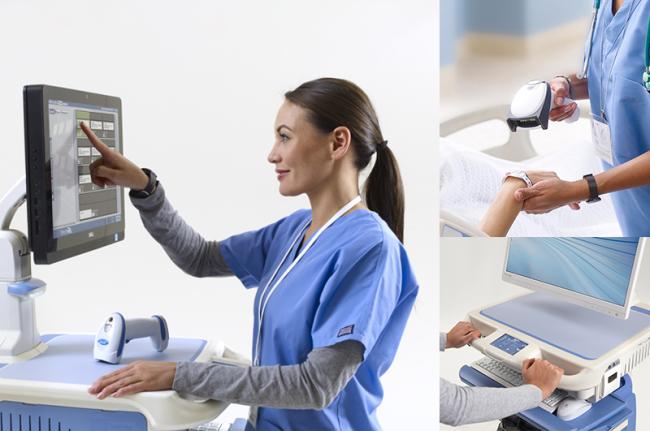Ergonomic Essentials: The Role of Mobile Workstations
Bending, lifting, and typing top the list of everyday motions performed multiple times every shift by nurses. It’s no wonder this population is more susceptible to developing work-related musculoskeletal disorders (MSD) than almost any other healthcare professional. Standing for long periods of time or sitting in awkward positions can also cause or aggravate the cumulating trauma disorders (CTDs) that lead to MSDs. Certain aspects of patient handling, as well as many repetitive motion tasks, are simply unavoidable in busy healthcare settings. But with attention to better ergonomics and investments in purposefully designed workstations, facilities have the power to preserve the health and well-being of the valuable nurses they employ.
If we think of ergonomics in terms of fitting a job to the worker, the answer is both!
The benefits of standing include burning more calories, reducing lower back strain, and increasing activity throughout the day. Sitting, on the other hand, uses less energy and helps stabilize the body to perform fine motor tasks like computer work or anything requiring accuracy and dexterity.
Adjustable workstations address the needs of all workers. And truly ergonomic models are easily raised or lowered to accommodate proper sitting and standing. In either position, a professional's eyes should roughly align with the top of the screen, and his or her forearms should be in line with the hands while typing. To further minimize both eye and neck strain, a mobile workstation must offer independent height adjustment of the monitor, as well as monitor tilt and swivel functionality to meet the user’s individual needs. When possible, supportive adjustable stools or ergonomic chairs should also be made available.
If we think of ergonomics in terms of fitting a job to the worker, the answer is both!
The benefits of standing include burning more calories, reducing lower back strain, and increasing activity throughout the day. Sitting, on the other hand, uses less energy and helps stabilize the body to perform fine motor tasks like computer work or anything requiring accuracy and dexterity.
Adjustable workstations address the needs of all workers. And truly ergonomic models are easily raised or lowered to accommodate proper sitting and standing. In either position, a professional's eyes should roughly align with the top of the screen, and his or her forearms should be in line with the hands while typing. To further minimize both eye and neck strain, a mobile workstation must offer independent height adjustment of the monitor, as well as monitor tilt and swivel functionality to meet the user’s individual needs. When possible, supportive adjustable stools or ergonomic chairs should also be made available.
Lifting quickly and awkwardly in high-stress situations will eventually take its toll on the backs and shoulders of essential staff members. So, adjustable workstations that are difficult to raise and lower could cause more harm than good. Whether choosing models with manual, crank or electric controls, facilities should ensure that staff members can make height adjustments without the exertion of lifting and lowering.
Most nurses are quite adept at working in confined spaces. But often, these exact conditions contribute to the type of awkward repetitive movements that leads to risky strain. Medical carts designed with user health in mind provide adequate space for monitors, keyboards and other essential items to be set up, stored, and accessed with ease, especially during demanding interactions with patients. An optimal setup is one where the keyboard/mouse height and monitor height are ideal in both sitting and standing postures. Adding anti-fatigue mats and footrests into the mix allows on-staff nurses to further improve the ergonomics of their workspaces.
The term “mobile workstation” reveals nothing about how much effort any given model requires one individual to push, pull, or park for hours on end. When looking to purchase new carts, facilities should focus on models that feature height-adjustable handles specifically designed to improve maneuverability. For specific guidance, Cornell University recommends a handle height between 35 to 45 inches from the ground to reduce musculoskeletal strain and improve ergonomics while in motion. Purchasers will also want to ensure carts have large caster wheels—great for rolling seamlessly over debris/irregularities, thresholds, and through elevators.
Also, on the subject of cart controllability through obstacle-course-like environments, it is important to note that the best carts are light enough to quickly set in motion but heavy enough to maintain balance and control over unpredictable surfaces.
With care and attention to the physical demands of nurses, any facility can help decrease the risks of developing CTDs and other workplace injuries by choosing more ergonomic equipment.
TouchPoint Medical’s mobile workstations, carts, stands, and mounts help managers deliver the best patient care while optimizing workflow, achieving security goals, and reducing staff fatigue through ergonomic solutions. Products can be configured to suit specific workflows and needs. For example, the AccessPoint™ workstation on wheels allows the nurses to quickly raise, tilt, swivel or rotate the monitor to find the perfect angle. It is also available with an electric lift option that offers a genuinely ergonomic design. Our medical carts meet Cornell University's 35-point ergonomic checklist. Our team is here to make the selection and implementation of all new equipment simple and straightforward. Check out our entire line of medical carts.



